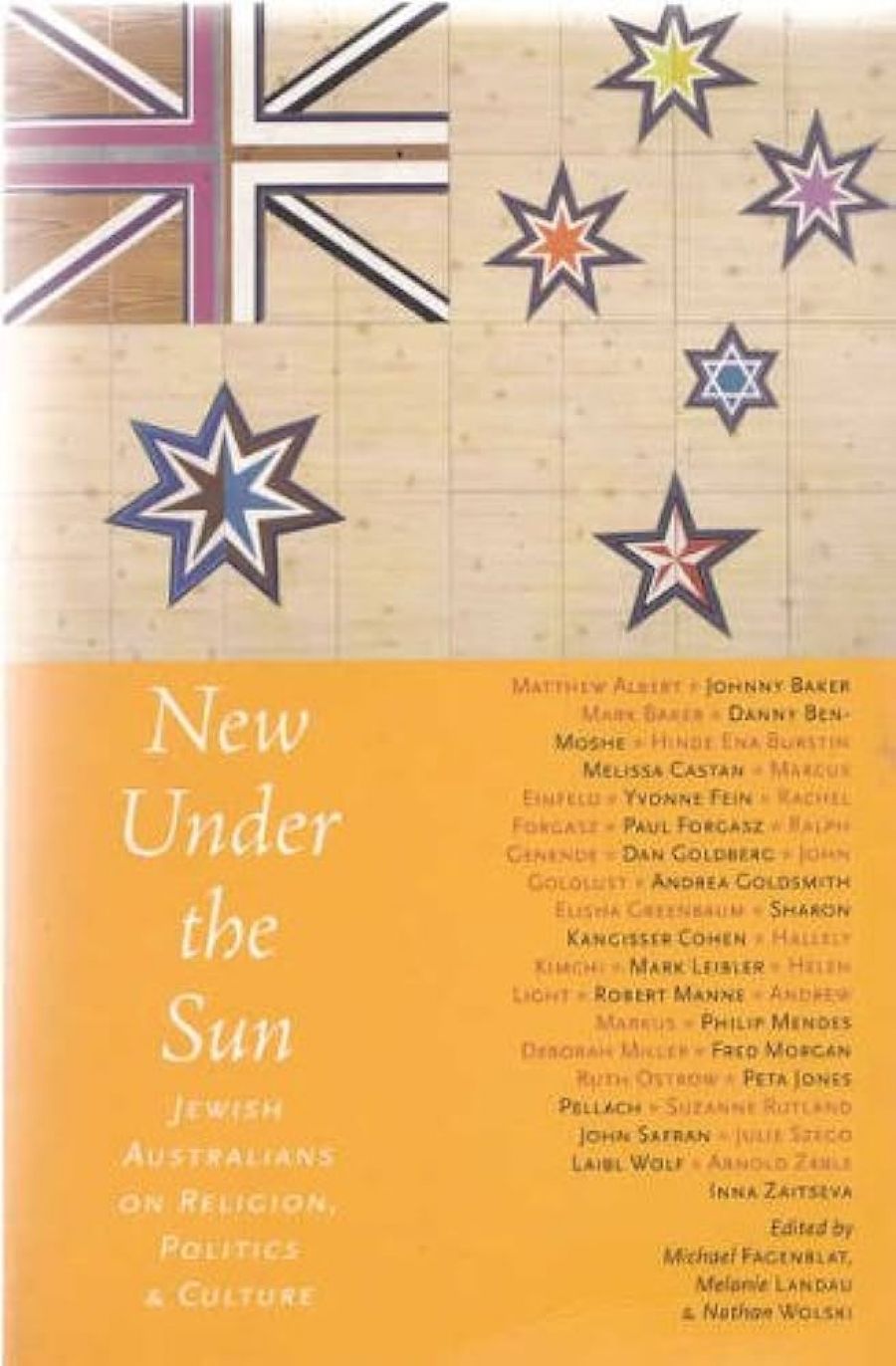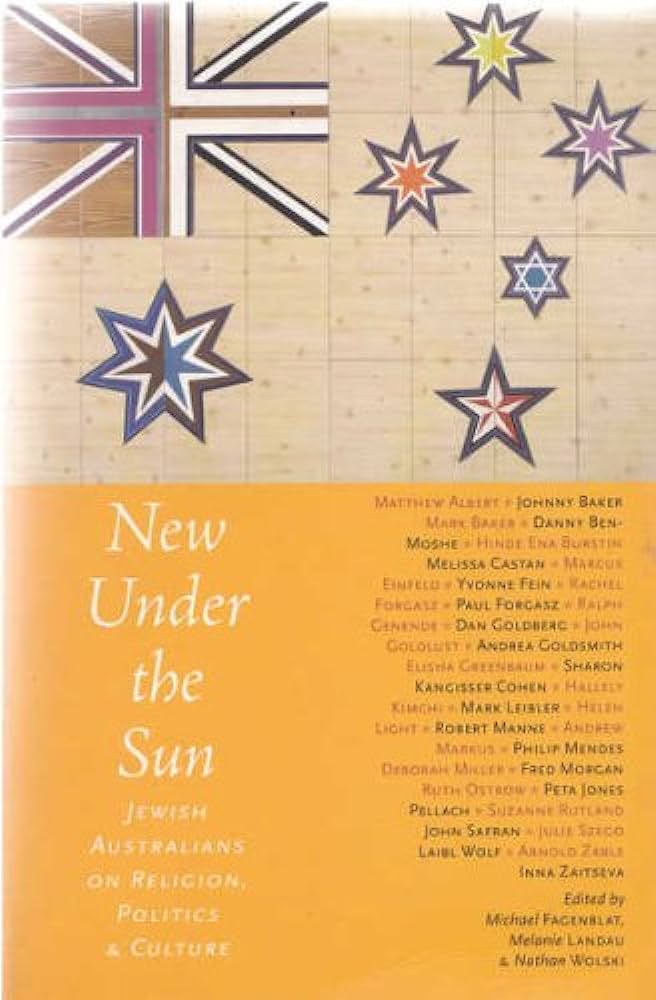
- Free Article: No
- Contents Category: Jewish Studies
- Review Article: Yes
- Article Title: Preserving the essence
- Online Only: No
- Custom Highlight Text:
This significant anthology consists of thirty-three articles by Jewish Australian scholars, lawyers, writers, educators, rabbis, journalists and other high achievers, prefaced by a thoughtful and wide-ranging introduction by the editors. Many of the contributors are distinguished in their fields and prominent in public life. The editors have cast the volume from a ‘perspective of commitment and belonging’, with the conviction that ‘challenge and critique when offered by committed members rather than hostile outsiders is often the most useful form of reckoning with ourselves’. The disjunction is troubling (I think I may be a hostile insider), but its effect does not diminish the interest of the collection. The book’s focus is narrower than its subtitle suggests: these are not just passing reflections by some Jewish Australians: each contribution is centrally about some aspect of the religion, politics and culture of Jewish Australians. As such, it provides a useful and authoritative synopsis of the progress, state and thoughts of many Australian Jews today. No single essay sparkles brilliantly, and a few are alarmingly deficient in serious thought; nevertheless, this is a big, rich, diverse collection deserving of wide public attention.
- Book 1 Title: New Under the Sun
- Book 1 Subtitle: Jewish Australians on religion, politics and culture
- Book 1 Biblio: Black Inc., $34.95 pb, 384 pp
- Book 1 Cover Small (400 x 600):

- Book 1 Cover (800 x 1200):

The essays (including a photographic essay by Emmanuel Santos) are arranged in five sections: Belonging; Politics; Seeking; Memory; Responsibility. The division is not entirely tidy. Much of what is of political interest appears under the heading of Responsibility. The Holocaust haunts many of the contributions, and not just those specifically dedicated to its memory. The theme of Jewish identity or belonging appears in some form in nearly all the pieces. Ethnocentric concerns predominate, though there are notable exceptions, such as Matthew Albert’s fine essay on the moral responsibility of Jews to other communities.
Common sense and science recognise the human need for identification with groups larger than family, but smaller than nation. There are tribes and, in large pluralistic societies, communities defined by religion and ethnicity, but also by mutual interests, sport, neighbourhood and so on. Jewish identity is a vexed confusion of religious, ethnic, racial and national notions, held together by powerful needs for group belonging and cohesion. Having an identity is not the same thing as belonging to a cohesive group, but for many Jews the national myths of the exodus and covenants, the harsh contingencies of Jewish history, the non-exclusive but unusually strong cultural expressions of ‘choseness’ and mission, have blurred the distinction. The establishment of Israel has not yet substantially diluted the defensiveness of this group feeling and, for the Jews of the Diaspora, has considerably complicated it.
For most of the contributors, maintaining Jewish identity as an embodiment of religious, racial or ethnic (cultural) characteristics, and resisting assimilation, are unquestioned and highly desirable ends. In fact, it seems highly questionable whether any group identities built around such characteristics have served humankind well. In my opinion, they are, by and large, pernicious. Be that as it may, in this collection only one essay, Robert Manne’s, considers the possibility of an identity constructed from different sources. Manne, with his customary precision, sketches some formative episodes in his intellectual development and describes his path to a Jewish identity that is ‘firmly rooted in the soil not of religion or ethnicity but of politics and history’.
Many of the essays note the vibrancy and achievements of the Australian Jewish community. The community is prosperous, though not uniformly, as trenchant essays by Inna Zaitseva and Philip Mendes on the exclusion of Russian immigrants and poverty make clear. Community institutions, especially the highly regarded schools, synagogues and other aspects of religious life, appear to be flourishing. The purpose of these institutions, the editors note, is ‘to strengthen the community and to nurture Jewish identity – to provide education, to guard against assimilation, to fight antisemitism and to support Israel’.
They have succeeded, but there are ominous clouds. An informative demographic analysis by John Goldlust, and a questionnaire-based study on attitudes to Zionism by Danny Ben-Moshe, lay out the facts and draw cogent conclusions. According to the 2001 census, there are probably between 105,000 and 112,000 Jews in Australia: the figure is an extrapolation, because an estimated twenty-five per cent (of all respondents) stated that they had no religion. Intermarriage is on the rise, with the trend most marked in the younger population: the percentage of males with Jewish partners has fallen from eighty-eight per cent in 1961 to 78.6 per cent in 2001. In a survey conducted in 1991, forty-five per cent of respondents said that they were Jewish but not religious. Ben-Moshe found that, although most Jews still support Israel, ties are weakening and support is more conditional and discriminating: ‘Overall the younger generations were not only more critical of Israel, they also expected more of Israel in the pursuit of peace.’
The bulwarks of Jewish identity – exclusive marriage, Zionism and religious practice – appear to be eroding. Julie Szego typifies some of the conundrums of Jewish identity and, most likely, the worst fears of its guardians. Szego says that she has ‘a rock-solid Jewish identity, but [is] avowedly faithless and agnostic’. When she ‘partnered out’ and wrote about it, some reactions were unkind. ‘Intermarriage,’ blasted one critic, ‘has always been and will always be an individual, spiritual and communal tragedy.’ Unexpectedly, Szego conditionally agrees: ‘the community is right to ... fear the process of assimilation. It is not racism or chauvinism to want to preserve our rich and powerful essence.’ She thinks there is a middle way: ‘The only way to fight assimilation is to make our community as diverse and inclusive as possible.’ Szego doesn’t explain how such inclusion differs from dilution, which is assimilation by another name.
Moreover, the memory of the Holocaust, which has been a potent unifying force, is also eroding. Mark Baker’s contribution is a moving, though darkling, meditation on the morality of remembering. Helen Light judiciously discusses the efforts of Jewish museums to keep memory and tradition alive. But the past inevitably grows dimmer. Some contributors wonder whether Australian Jewry will go the way of the United States, where intermarriage rates are steep and religious practice is diffuse. Can secular Jewishness, Goldlust asks, torn by the forces of assimilation and ‘devoid of religious belief or practice continue to engage future generations’?
The dispensation of Jewish faith is scattered across a broad spectrum. At one end are the ultra-Orthodox. Until recently, they have kept largely to themselves. One branch of ultra-Orthodoxy, however, Chabad (Lubavitch), has been singularly active in community service and support, religious education and training, and now largely dominates the synagogues and the purvey of ceremony and ritual: circumcision, funerals and so on. It has eclipsed the other branches, Modern Orthodoxy and the Liberals (or Progressives), and gained a disproportionate influence among Australian Jewry, albeit a problematic one: much of the constituency consists of the paradoxical ‘traditional Orthodox non-practising Jew’. More prevalent in Australia than anywhere else on earth, they are, the editors explain, marked by ‘the vigour with which they defend the Orthodoxy they do not practise’, and their insistence that ‘the shul (synagogue) they do not go to must be orthodox’.
In one of the best essays, Modern Orthodox Rabbi Ralph Genende probes the paradox. He briefly describes the framework of Modern Orthodoxy (as Rabbis Greenbaum and Morgan, respectively, describe their Chabad and Progressive branches), but his main concern is to reckon with the surge of ultra-Orthodoxy, Chabad in particular, at the expense of Modern Orthodoxy. The latter, rooted in the Enlightenment, believes in the compatibility between Judaism and secular science and culture. Chabad does not, and Genende is puzzled by its appeal to people who in other respects have secular values. His analysis is insightful; Chabad has provided charismatic leadership and seems ‘authentic’; it propagates the view that secular Jews have a ‘Jewish soul’ that keeps them Jewish whatever they do; it offers absolutes and definitive answers. In short, Chabad is ‘part of a world-wide disenchantment with secular decadence. In this respect they are riding the wave of fundamentalism that has swept across the world.’
Of several essays on Jewish spirituality, Rabbi Laibl Wolf’s is the most lively. According to Wolf, our souls (the soul being ‘an internal antenna of absolute truth’) sense the emptiness of the modern secular world and cry out for true spirituality. That explains the ‘resurgence of ancient wisdoms, amongst which is the Kabbalah’. The cry must be exceptionally loud from Jews, for ‘it has been said that sensitivity, spirituality and searching is the mark of the Jewish soul’. The very same thing has been said about Nordic and Slavic souls, though Wolf may not know that. In any case, there is now an ‘ever-increasing pool of wacky, woolly and well-intentioned spiritual seekers’, which of course makes a market, and Wolf has a kvetch about it. Many Jews are turning to spiritual snake oil: Eastern meditation, astrology, yoga, and phoney Kabbalah; ‘the real Kabbalah has been hijacked by scheming financiers.’ Wolf decries this kitsch spirituality, which he lampoons as sitting in lotus position chanting ‘Shalom’ and ‘retreating to Byron Bay to study obtuse [sic] writings of the Zohar’. Authentic Kabbalah and Jewish spirituality, he explains, is grounded in Torah learning and practice. Wolf’s essay is a pre-emptive strike on the one that follows. Ruth Ostrow relates how she ‘yearned to be in love ... with Self as manifestation of Divine energy’, did move to Byron Bay, converted to Buddhism and now lives as an ethnically Jewish ‘eclectic spiritualist’. Ostrow also touches on the depreciation of women in some branches of Judaism. This neglected subject is explored in an earnest essay by Yvonne Fein.
Curiously placed under the heading of ‘Responsibility’ (not ‘Politics’), Marcus Einfeld’s and Arnold Zable’s trenchant and passionate essays condemn the racism, cruelty and lawlessness of the Howard government’s treatment of asylum seekers. Reviewing the work of her father, Ron, Melissa Castan berates those who oppose Aboriginal land rights and equates the ‘refusal to apologise’ with Holocaust denial. The Howard years are indeed bleak. Mendacity, cruelty, disregard for law, and the perversion of public administration are likely to dominate the index of its legacy. Perhaps worse, for we have become accomplices to war criminals and monsters in suits.
Many Jewish Australians, several represented in this collection, have been prominent in resisting this degradation of the nation’s political and cultural life. But according to Dan Goldberg’s astonishing paean to Howard in his essay on the psyche of Australian Jews, issues of social policy, mandatory detention and the like don’t cut with most Jews as long as the economy and the alliances with Washington and Jerusalem hold firm. Goldberg argues that most Jews feel safe with Howard: he is perceived to be one of us. Goldberg doesn’t make the reasons for these (mis)perceptions coherent, but I fear that he may be right.


Comments powered by CComment